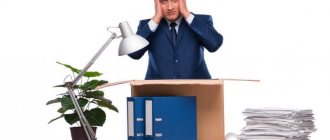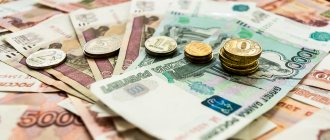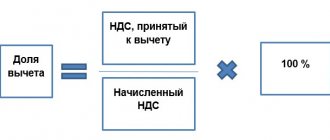Write-off of VAT not deducted in tax accounting
There are some features of writing off VAT, which was not previously accepted for deduction in accounting and tax accounting. In order to accept the payment amount for reimbursement, certain conditions established in the Tax Code in Articles 171, 172 must be met.
If the documents, including those in 1C, are completed incorrectly, the amount cannot be deducted, and the question arises of how to write off VAT, because this action must be performed. The need to exclude a payment may arise if the tax service has refused a refund.
There are some peculiarities of writing off VAT on expenses; to complete the operation, several transactions must be recorded. For example, an organization received a service subject to interest.
What postings will need to be made:
- DT26KT60 – receiving a service;
- DT19KT60 – fixation of incoming tariff;
- DT68KT19 – presentation of the amount for compensation.
If during the tax inspection process it is determined that there is a gap, the fiscal authority may refuse the deduction. Unaccepted fees are written off as expenses of the organization.
You will need to make the following entries:
- DT68KT19 – reversal;
- DT91KT19 – write-off of incoming payment as expenses.
When determining the taxable profit indicator, unaccepted tax is not taken into account, according to existing legislation. This payment also cannot be included in the price of goods or work according to the Tax Code. If the amount is not accepted for deduction, then it is written off as expenses on 91 accounts.
How to avoid denial of deductions
VAT accounting practice shows that the Federal Tax Service may refuse to deduct in the following cases:
- the invoice from the supplier contains errors;
- there is no invoice from the supplier, and the tax is highlighted in the receipt documents;
- the supplier did not reflect the transaction in tax documentation (in the sales book);
- The three-year period for submitting VAT for deduction has expired.
The risk of failure can be minimized if:
- carry out preliminary reconciliation with counterparties, primarily permanent, large transactions associated with the company;
- store primary accounting and tax documents in full;
- do not miss the deadlines specified in the legislation for VAT deductions.
Reason for write-off
In order to write off a certain amount of the fee as price added, there must be appropriate grounds. A transaction with a counterparty must be confirmed by an invoice - an invoice, an invoice, or a work certificate.
You can receive a deduction for added value only if the goods were capitalized, the work was performed and reflected in accounting, the delivery of products and the performance of work are accompanied by primary documents.
The right to compensation for an incoming payment may arise if the business transaction was confirmed by the counterparty’s UPD. If the required document is not available or it is drawn up incorrectly, it is impossible to deduct the amount.
Incoming VAT account
Inclusion of VAT in the buyer's expenses The amounts of tax that are presented to the buyer are included in his costs when using products, works, services:
- In the manufacture/sale of objects, operations for the sale of which are not subject to taxation (exempt) under paragraphs 1-3 of Art. 149 NK.
- The production/transfer of products, services, works, operations for which for one’s own needs are considered subject to taxation under Ch. 21, but are not subject to tax accounting under paragraphs 2, 3 of Art. 149 NK.
- Sales outside the territory of the Russian Federation.
For the VAT amounts presented to the buyer, the following entry is made: “Db 20 (44, 23, 26, 25, etc.) Kd 19.”
Correct paperwork
You can highlight some nuances when preparing documentation when writing off a payment. Most often, documentation is drawn up in a special program - 1C. You can generate a “Write-off” document by entering based on receipt or by selecting the journal of routine operations and creating a new document.
To fill in the “tax to be written off” parameters, you can use the data from account 19 in the “Value added tax presented” register. The name of the document that serves as the basis and information about the supplier, amount and invoice are registered in the program automatically. Additionally, you will need to fill in data on the tax amount, indicate the type of value and interest on tariffs.
Postings to account 19 - value added tax
If the purchased goods were used by the organization for production purposes, the amount of “input” VAT is subject to reimbursement based on a correctly executed invoice received from the supplier. The accountant, reflecting the fact of accepting VAT for accounting and presenting it for deduction, makes the following entries: Dt Kt Description Document 19 60 The amount of VAT paid to the supplier of the goods is taken into account Invoice 68 VAT 19 VAT accepted for deduction Invoice Sub-accounts on account 19 When reflected amounts of VAT on account 19, an organization can open sub-accounts by type of goods purchased: Typical entries on account 19 Account 19 is widely used when reflecting VAT on mutual settlements with suppliers and contractors. In addition, the amount of VAT may be deducted from the cost of goods (services) received from third parties.
Write-off of allocated VAT for other expenses
Write-off of allocated VAT for other expenses can be carried out in situations provided for by existing legislation. Sometimes in accounting work there may be cases where the costs of paying a fee cannot be reimbursed. Then the popular question is where to write off the tariff.
According to Article 170 of the Tax Code, the amount of input tax is not included in the expenses that are taken into account when calculating income tax. The payment can be attributed to expenses if the products will be used in non-taxable transactions, the place of sale of the goods will not be the Russian Federation, the person is exempt from making payments or is not a payer due to the use of special regimes.
There are several options for expensing tariff exclusion, the use of which depends on the application of the specific regime. If the payer uses UTII, the amount of the fee is included in the price of goods or materials at the time of posting.
If a person works under the simplified “Income” method, the tax can be taken into account in expenses in different ways. If the simplified “Income – Expenses” system is used, the collection on purchased assets can actually be taken into account after their sale. To exclude payment, you must prepare all the necessary documents.
Postings with example
Let’s assume that a company purchased materials from a supplier in the amount of 180,000 rubles, incl. VAT 20%. The supplier did not record the transaction in sales (the so-called tax gap), and as a result the company was denied a deduction. 180,000: 1.2 = 150,000 rub. 180,000 – 150,000 = 30,000 rubles.
Postings:
- D10 K60 — 150,000 rub.
- D19 K60 — 30,000 rub. — inventory items are capitalized and VAT is allocated on them.
- D68 K19 — 30,000 rub. — input VAT is deductible.
After checking by the Federal Tax Service and refusing the deduction:
- D68 K19 — 30,000 rub. — the posting is reversed.
- D91 K19 - write-off of VAT as expenses.
Instead of 91, the score 99 can be used.
Please note that according to tax legislation, the counterparty can send a confirming invoice not immediately, but within 3 years. It is advisable to write off VAT no earlier than this period expires.
By default, “stuck” VAT is not reflected in income tax calculations (Article 170 of the Tax Code of the Russian Federation):
- does not reduce the taxable amount;
- is not included in the costs of goods, services, and works.
The given wiring diagram complies with the norms of the Tax Code of the Russian Federation.
New rules for attributing VAT that is not deductible
There are some changes in legislation that should be taken into account when writing off VAT on expenses. Previously written off VAT, which was not accepted for refund, was charged as expenses and included in the price of goods.
According to the new wording of Article 170, the write-off of VAT applied to expenses is carried out differently. If the fee is not deductible, it is taken into account in the cost of goods, including fixed assets and intangible assets.
This rule applies to objects used in carrying out operations exempt from the fee, applies to the sale of goods outside the Russian Federation, and is used when purchasing goods by firms that have the right not to pay a fee using the exemption.
Moreover, if an organization conducts taxable and non-taxable activities, then it must carry out separate accounting of the input tariff. Tax on products used for activities subject to the tariff is deductible. If the tax applies to a preferential product, it increases its cost.
Typical accounting entries for VAT: tax accounting
Tax Code of the Russian Federation). Transaction Posting VAT on purchased goods is taken into account Debit of account 19 — Credit of account 60 “Settlements with suppliers and contractors” (Credit of account 76 “Settlements with various debtors and creditors”) VAT on purchased goods is included in the cost of these goods Debit of account 41 “Goods” — Credit to account 19 Also, depending on the situation, account 19 may correspond with accounts 10 “Materials”, 08 “Investments in non-current assets”, etc. VAT restoration: posting If VAT previously accepted for deduction needs to be restored, then the VAT posting will depend on the reason why the input tax is subject to restoration. We have provided examples of transactions when restoring VAT for the most common reasons in the table. Situation Posting VAT is restored from the advance payment transferred to the seller (clause 3, clause 3, article 170 of the Tax Code of the Russian Federation). Moreover, it does not matter why the advance VAT is restored.
In what cases is the VAT write-off document used?
To account for VAT on expenses, a special 1C program is used. In it you can create a “Value Added Tax Write-off” form. It reflects the acceptance of the submitted fee for reimbursement by the counterparty. The exclusion of payment may be relevant if goods and other valuables are purchased by an accountable person.
The document is generated by entering based on receipts or using the transaction log for tariffs and creating a new form. In addition, you will need to display the dates of compilation, indicate the type of value, and the amount excluding tax.
VAT deduction: application features
22 Altai Territory Date of publication: 02/29/2016
Edition: “My Tax Advisor”, No. 2, February 2016 Topic: Value added tax Source: https://www.uic22.ru/content/blogcategory/22/55/
Features of application VAT deduction: transfer of VAT deduction on goods (works, services), fixed assets, determination of a three-year period when transferring VAT deduction, application of VAT deduction on an invoice received late
VAT deduction in parts in different tax periods
The taxpayer has the right to reduce the total amount of VAT calculated in accordance with Art. 166 of the Tax Code of the Russian Federation (hereinafter referred to as the Code), for tax deductions (clause 1 of Article 171 of the Code). The deduction includes, among other things, VAT amounts presented to the taxpayer when purchasing goods (work, services) for carrying out transactions recognized as objects of VAT taxation, or for resale (clause 2 of Article 171 of the Code).
Deduction of VAT amounts is carried out on the basis, in particular, of invoices issued by sellers of goods (work, services) after the registration of these goods (work, services) and in the presence of relevant primary documents (clause 1 of Article 172 of the Code).
In accordance with the newly introduced clause 1.1 of Art. on January 1, 2020. 172 of the Code, the specified tax deductions can be claimed in tax periods within three years after the registration of goods (work, services) purchased by the taxpayer on the territory of the Russian Federation or goods imported by him into the territory of the Russian Federation. Thus, the deduction of value added tax on the basis of one invoice in parts in different tax periods within three years after registration of goods (work, services), with the exception of fixed assets, equipment for installation and (or) intangible assets , does not contradict the norms of the Code. This position is explained by the norms of paragraph. 3 p. 1 art. 172 of the Code, according to which deductions of tax amounts presented by sellers to the taxpayer upon acquisition or paid upon import into the territory of the Russian Federation and other territories under its jurisdiction of fixed assets, equipment for installation and (or) intangible assets specified in paragraphs 2 and 4 Article 171 of the Code are carried out in full after registration of data on fixed assets, equipment for installation and (or) intangible assets (letter of the Ministry of Finance of the Russian Federation dated May 18, 2015 No. 03-07-R3/28263). The amount of “input” VAT on fixed assets, intangible assets and equipment for installation cannot be claimed for deduction in different tax periods in parts. In accordance with clause 1.1 of Art. 172 of the Code, a taxpayer can declare this amount of VAT for deduction in any quarter within three years from the date of registration of the relevant object. Established in clause 1.1 of Art. 172 of the Code, the rule giving the right to take advantage of a deduction in any quarter for three years does not apply to all tax deductions, but only to those provided for in paragraph 2 of Art. 171 of the Code. This applies, for example, to VAT: a) calculated by the seller on advances received for future deliveries of goods, performance of work, provision of services, transfer of property rights (clause 8 of Article 171 of the Code); b) presented to the buyer when he transfers advances against upcoming deliveries of goods, performance of work, provision of services, transfer of property rights (clause 12 of Article 171 of the Code); c) paid by buyers - tax agents, which are specified in clause 3 of Art. 171 Code; d) calculated according to construction and installation works for own consumption (clause 5 of Article 172 of the Code); d) presented for travel expenses. In this regard, such deductions should be made in the tax period in which the taxpayer has met the appropriate conditions provided for in Art. Art. 171 and 172 of the Code (letter of the Ministry of Finance of the Russian Federation dated 04/09/2015 No. 03-07-11/20290, letter of the Ministry of Finance of the Russian Federation dated 07/21/2015 No. 03-07-11/41908). When claiming a deduction in parts for one invoice, questions may arise regarding filling out the purchase book, namely column 15 “Cost of purchases on the invoice” and 16 “VAT amount on the invoice accepted for deduction.” It should be noted that in this case the invoice will have to be registered several times. In column 16, each time you need to indicate only that part of the amount of “input” VAT that is claimed for deduction in the current quarter. As for column 15, it should reflect the entire cost, which is indicated in column 9 on the “Total payable” line of the corresponding invoice. The requirement for filling out column 15 is established by the Rules for maintaining a purchase book (approved by Decree of the Government of the Russian Federation of December 26, 2011 No. 1137).
Deduction of VAT on invoices received late
A prerequisite for deducting input VAT is the presence of a correctly executed invoice from the seller. This means that, in general, the deduction of “input” VAT on goods (work, services) accepted for accounting can be claimed by the taxpayer only after receiving the corresponding invoice from the seller. According to the provisions of paragraph 1 of Art. 171 of the Code, VAT payers have the right to reduce the total amount of tax calculated in accordance with Art. 166 of the Code, for tax deductions established by this article. At the same time, paragraph 1 of Art. 172 of the Code provides that such deductions are made on the basis of invoices issued by sellers when the taxpayer purchases goods (work, services), property rights, documents confirming the actual payment of tax amounts when importing goods into the customs territory of the Russian Federation, documents confirming payment of tax amounts , withheld by tax agents, or on the basis of other documents in the cases provided for in paragraphs 3, 6-8 of Art. 171 of the Code. Thus, the taxpayer’s right to deduct “input” VAT arises when the following conditions are simultaneously met: - goods (work, services) were purchased to carry out transactions subject to VAT; — these goods (works, services) are registered on the basis of the relevant primary documents; — a properly executed invoice from the seller is available. At the same time, in practice it often happens that goods are registered in one tax period (quarter), and the invoice is received from the seller in another. In such a situation, obviously, from the literal interpretation of these rules it follows that the deduction can be claimed only in the period when the invoice is received. Meanwhile, as the Russian Ministry of Finance indicated in letter No. 03-07-11/59682 dated October 19, 2020, there is an exception to this rule. In accordance with clause 1.1 of Art. 172 of the Code, the period for accepting VAT for deduction in the situation under consideration depends on exactly when the “late” invoice was received - before or after the expiration of the period allotted for submitting a declaration for this period. Let us recall that Art. 174 of the Code requires reporting VAT no later than the 25th day of the month following the reporting quarter. In practice, taxpayers upon receipt of “late” invoices may encounter the following situations: - the invoice was received before the 25th day of the month following the quarter in which the relevant goods (work, services) were registered, and the declaration for this period has not yet been presented. In this case, the taxpayer should register the “late” invoice in the purchase book for the quarter in which the goods were registered, in accordance with the general procedure. And, accordingly, in the VAT return for a given period, you can declare the “input” tax on these goods (works, services) for deduction. - the invoice was received before the 25th day of the month following the quarter in which the relevant goods (work, services) were accepted for registration, but the declaration for this period had already been submitted. In such circumstances, the invoice should be registered in an additional sheet to the purchase book for the period in which the goods were registered, and the taxpayer should submit an updated VAT return to the tax authority for this period. - the invoice was received after the 25th day of the month following the quarter in which the corresponding goods (work, services) were registered. In this case, the deduction can be claimed no earlier than the period in which the invoice was received. In conclusion, it should be noted that the new norm of paragraph 1.1 of Art. 172 of the Code is more relevant for taxpayers who receive invoices electronically, since in this case the date of actual receipt of the invoice is clearly determined by the electronic document management system.
Account 19 in accounting: subaccounts, postings, closing
In the same period, the purchased spare parts were sold to Avtolyubitel LLC at a price of RUB 241,500, VAT RUB 36,839. Reflecting these transactions and determining the financial result for January 2020, the accountant of Prometheus LLC made the following entries in the accounting: Dr Ct Description Amount Document 41 60 A batch of auto parts was received at the Prometheus LLC warehouse (RUB 154,300 - RUB 25,537) 128 763 rub. Consignment note 19 60 The amount of VAT invoiced by Mashinostroitel JSC is taken into account: RUB 25,537.
Consignment note, invoice 68 VAT 19 The amount of VAT claimed for deduction is RUB 25,537. Invoice 60 51 Funds transferred to Mashinostroitel JSC to pay for spare parts RUB 154,300. Payment order 90.2 41 The cost of spare parts intended for sale is reflected in expenses RUB 128,763.
Consignment note, purchase and sale agreement 62 90.1 The amount of revenue from the sale of spare parts is taken into account: RUB 241,500.
Attention
Features of tax reimbursement from the budget The tax paid within the cost of purchased goods is reimbursed to the company if the purchased goods or services received were used in the main activities of the enterprise and only for transactions that are subject to VAT (Tax Code of the Russian Federation, paragraph 4 of Article 170). Otherwise, it is either fully included in the cost of goods or distributed between taxable and non-taxable transactions. That is, settlement documents are prepared without allocating the amount of tax (or part thereof) from the total expenses associated with the purchase.
Until 2014, it was also necessary to issue invoices, even if the transaction is not subject to VAT (Article 149 of the Tax Code of the Russian Federation). In this case, the note “No tax” was placed. However, as of January 2014, new regulations came into force.
But be careful: the procedure for paying for “children’s” sick leave remains the same! <... Online cash register: who can take the time to buy a cash register Individual business representatives may not use online cash register until 07/01/2019. However, for the application of this deferment there are a number of conditions (tax regime, type of activity, presence/absence of employees).
So who has the right to work without a cash register until the middle of next year? <... This operation is reflected in two entries:
- Db 41 Kd 60 – the cost of purchased products is taken into account: 10,169.49 rubles.
- Db 19 Kd 60 – shows the input VAT on the purchase of goods RUB 1,830.51.
At the end of the reporting year, the company writes off the VAT amount to the account. 68. Thus, the organization uses its right to reduce debt to the budget. The following entry is made: “Db 68 Kd 19 – the amount to reduce the amount of accrued tax of 1830.51 rubles is transferred to the debit of the account for settlements with the budget.” In the same March, the company sells products to its own customers at a cost 1.5 times higher than the purchase price (18 thousand rubles).
When can VAT be included in expenses?
We said earlier that VAT cannot be taken into account in a company’s expenses. There are, however, exceptions to this rule.
In some cases, it is not possible to claim VAT for deduction, but it is possible to write it off as expenses (according to the text of Article 170 of the Tax Code of the Russian Federation, paragraph 2.5, Article 169-3(1), letters of the Ministry of Finance No. 03-07-07/72 dated 02/11/10, 03-07-08/195 from 01/10/09, 03-11-06/3/227 from 03/09/09):
- The VAT amounts actually paid at the time of import of goods into the territory of the Russian Federation, if they will be used, in turn, in the production of tax-free goods. The same applies to works and services.
- In certain cases of the Tax Code of the Russian Federation, VAT is included in the profit costs of banks, pension funds (non-state), insurance companies, clearing firms, stock market participants, etc.
- The company is in a special regime and is exempt from paying taxes. Here you need to keep in mind that invoices may not be issued to such companies upon purchase, however, provided that an agreement on this is concluded between them and the seller.
- Amounts of VAT on purchased goods, works, services, if they are subsequently used in production or sales outside the Russian Federation.
- The acquisitions will be used in operations that are not sales under the Tax Code of the Russian Federation.
We recommend reading: Meals for employees, sample documents
When creating transactions, it would be correct to first allocate VAT and then charge it to expenses.
How to write off VAT correctly in the 1s program?
This operation is reflected by the entries:
- Db 90.2 Kd 41 – the cost of goods sold is shown as RUR 10,169.49.
- Db 62 Kd 90.1 – accounting for the buyer’s debt to the enterprise 18 thousand rubles.
Info
In the process of selling work, products or services to the public for cash, the requirements for drawing up documents and issuing invoices will be considered fulfilled if the seller has handed over a cash receipt to the buyer. He may submit other supporting paper in the prescribed form. Invoice This is a document that serves as the basis for accepting tax amounts for reimbursement or deduction.
Mandatory invoice details are established in paragraph 5 of Art. 169 NK. The document must be signed by the chief accountant and director of the enterprise or other persons authorized by them. The invoice is certified by a seal. The seller must have a journal for recording these documents and a sales book. The acquirer, accordingly, must also record received invoices in the appropriate catalogue. A purchase book is also required.
Attention! If the purchased goods (work, services) are not intended for operations subject to VAT, then the amounts of “input” VAT on such goods (work, services) are not deductible.
In accordance with paragraph 2 of Art. 170 of the Tax Code of the Russian Federation, the amounts of “input” VAT on purchased goods (work, services), including fixed assets and intangible assets, are taken into account in their cost
, if these goods (works, services) are purchased:
production operations
and (or) sale of goods (work, services) (transfer of goods (work, services) for one’s own needs), not subject to VAT (exempt from taxation);
2) for use in carrying out operations for the production and (or) sale of goods (works, services), place of sale
which are not recognized by the territory of the Russian Federation;
3) for the production and (or) sale of goods (work, services), operations for the sale (transfer) of which are not recognized as the sale of goods (work, services) in accordance with clause 2 of Art. 146 Tax Code of the Russian Federation;
4) persons who are not VAT taxpayers, or persons exempt from taxpayer obligations in accordance with Art. 145 Tax Code of the Russian Federation.
In all the situations listed above, the amounts of “input” VAT are not reflected in account 19, but are taken into account in the cost of purchased goods (work, services). Invoices received from suppliers are filed in the journal of received invoices without registration
in the purchase book.
Note!
Non-deductible tax
However, input tax may not always be deductible.
Above we mentioned conditions that must be met, but sometimes this does not happen. For example, along with its main activities subject to VAT, the organization carries out transactions that are not subject to this tax. In this case, tax is not deductible.
If we are talking, for example, about materials, then the following accounting entry will be made:
- Dt 10 - Kt 19 - for the amount of non-deductible VAT.
What does this wiring mean? VAT, which is not deductible, is included in the cost of materials. Since not only materials, but also other valuables can be purchased, account 19 in this posting can correspond with other accounts. For example, if goods are purchased, the posting will take the form: Dt 41 - Kt 19. Non-deductible tax on assets that will be used to ensure the operation of the organization can be written off with the posting: Dt 29 - Kt 19. If the organization carries out an additional type of activity that is not subject to VAT, then the tax on the assets acquired for her can be written off as follows: Dt 23 - Kt 19. It happens that the amount of tax is allocated in the documents, but the invoice is lost or was not received.
Then the tax can be written off for other expenses: Dt 91 - Kt 19.








